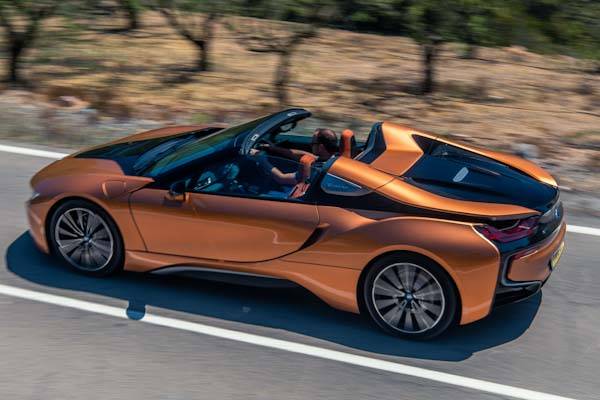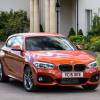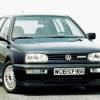
RAC sale – up to 33% off*
• Roadside cover from £5.29 a month†
• We get to most breakdowns in 60 mins or less
• Our patrols fix 4/5 breakdowns on the spot

By Jonathan Crouch
Introduction
The BMW i8 aimed to re-define the art of sports car design - both technologically and aesthetically in this Roadster guise. It may not be the ultimate contender of its kind from the 2018-2020 period to drive but it could well be the ultimate model of this type to own. This is, after all, a plug-in petrol/electric hybrid super sports car that runs silently on its battery in the morning commute, yet can transform itself into a high performance GT when you're in the mood. It also looks sensational, feels special and will slash your running costs to the bone.
Models
2dr Roadster
History
You're looking at a model that claimed to represent the future of open-topped sports cars. One that was light, strong, very fast and more than able to justify its position on the planet. Welcome to BMW's revolutionary i8 Roadster, sold briefly between 2018 and 2020.
You might be familiar with the i8 Coupe, the model that democratised sophisticated hybrid technology in the high performance super sports car segment. Until this revolutionary model arrived in mid-2014, plug-in petrol/electric sportscar motoring required the billionaires' budget needed for ownership of hypercars like the Porsche 918 Spyder, the La Ferrari and the mighty McLaren P1. At a stroke, this BMW changed all of that, delivering an equally sophisticated taste of the future, but doing so for realistic Porsche 911 money.
Originally, BMW designed the i8 as a Coupe, but showed a Spyder concept version at the Beijing Motorshow in 2012 to see if there would be enough customer interest in an open-topped version. There was and when the design team removed the roof of a fixed-top model and found the carbon fibre chassis easily stiff enough to support a convertible format, the Munich maker gave the green light for production. Following which the i8 Roadster was launched in the Spring of 2018.
It arrived on the market at the same time as the i8 Coupe was receiving a significant update, most notably to its rather unique powertrain. That's based around the use of two gearboxes, three electric motors and a sophisticated three cylinder turbo petrol engine, this boosted by a 200kg bank of hi-tech lithium-ion batteries and transmitting torque to the tarmac via a four wheel drive system. As part of the mid-term improvements, BMW has added 12hp to the engine output, while upgrading the cell capacity of the lithium-ion battery to 34Ah and increasing its energy capacity to 11.6kWh, in the process raising this car's potential pure electric driving range by 10 miles to 33 miles.
It was all enough to further distance this i8 from its conventional super sports car rivals. And in this Roadster form, buyers got an extra element of exotic desirability. But would you really pay Porsche 911 money for a three cylinder 1.5-litre Plug-in hybrid convertible? We think you might if you're in the market and have half a care for the environment. The i8 in both Coupe and Roadster forms sold until 2020 - and wasn't replaced.
What You Get
Even standing still, there's a sense of theatre about this i8, with a riot of complex surface treatments, contrasting colours, sharp creases and scalloped sills. For this Roadster version, BMW revised this car's distinctive dihedral doors to integrate frameless windows and better fit with the new roof arrangement. It's a fabric top that activates in 15 seconds at speeds of up to 31mph, folds in a Z-shape and stows vertically in the space where tiny back seats would be in the Coupe model, nestling between the rear bulkhead and the mid-rear-mounted combustion engine. As ever in an i8, the packaging is necessarily intricate, given the need to accommodate two gearboxes, three electric motors, a three cylinder turbo petrol engine, a 200kg bank of hi-tech lithium-ion batteries and all the associated technology of 4WD.
It's all built into what the brand calls a 'LifeDrive' design approach, the name designating the two separate platform segments that combine to create the underpinnings of this car. First up is the aluminium 'Drive module' that shrouds the combustion engine and electric motor, the battery pack and various power electronics and chassis components. This connects to the separate 'Life module', the name BMW gives to this i8's CFRP 'carbon-fibre-reinforced plastic' passenger cell. Because of this, the designers of this Roadster model didn't need to build in additional structural reinforcement to make up for the removal of the roof. There are some additional panels in the rear suspension and the strengthened windscreen frame is fashioned out of reinforced CFRP, but that's about it.
In the cabin, you'll find the styling as futuristic as it was outside, the curved, layered dash made up of overlapping three-dimensional segments and complemented by contrasting colours. Cocooned yet surprisingly roomy, the driver-focused cockpit envelopes you with slender blue-stitched leather sports seats, re-designed here as part of a package of mid-term i8 updates that also included the standard inclusion of these carbon fibre trimming panels and the addition of touchscreen functionality for the 8.8-inch iDrive infotainment monitor positioned at the top of the dash.
Most arresting though, is the display you view through the grippy three-spoke wheel, a sci-fi-style screen, also 8.8-inches in size, which delivers range readings for fuel and battery power below two circular digital dials that change in colour depending on the driving mode you select.
On to interior practicalities and, as is the sports car norm, cabin storage space is somewhat limited, not helped here by the fact that there are no door pockets. Obviously, the deletion of the Coupe model's rear seats doesn't help either, though to compensate, BMW provided 100-litres of storage capacity between the roof box and the seat backs, which is compartmentalised into three parts and is ideal for stuffing coats and soft bags into.
Let's finish with a look at boot space. It's just as well that that extra space behind the seats was freed up because there isn't much room available in the boot - just 88-litres - around half the trunk space offered to buyers of the Coupe version.
What You Pay
Please fill in the form here for an exact up-to-date information.
What to Look For
Obviously check the condition and working of the electrically-powered top, but you're unlikely to encounter any issues. Otherwise, it's just as with any other i8 Coupe - and probably better because by the time of this Roadster variant's introduction, BMW had ironed out most of the major issues with this car. Our owner survey did reveal one i8 owner with serious issues relating to drivetrain and overheating, probably related to a problem with the central controller (which is expensive to replace). Basically, if you have any sort of issue, it's likely to be expensive, so inspect carefully and obviously, insist on a fully stamped-up service history.
Apparently the fuel pressure sensor will fail in time, which is pricey to fix, but won't actually stop you driving. One owner's i8 had been at his dealer's for a lot for minor stuff, like fuel pressure sender, struts, wipers, and software - and the petrol motor blew up. One owner had to replace the fuel filler cap door; another had a 'coolant low warning' issue when there was plenty of coolant (traced to a sensor issue). Another owner got a 'Drivetrain cannot restart' error message and his car had to visit his dealer for four high voltage battery modules. If you're getting an older i8, try to get a warranty. The electric portion of the hybrid system electric motor, electronics and high voltage batteries was from new covered for 8 years/100k miles from BMW. Otherwise, it's just the usual things. Look for signs of interior damage and check the alloys for scratches and scuffs.
Replacement Parts
[based on a 2017 model i8 Roadster auto] Parts prices for an i8 can be expensive if it's a major mechanical item, so buy carefully. Consumables are OK though. For instance, we found front brake pads at around £193 for a set (and rear pads for around £60); and an oil filter would cost around £17.
On the Road
The i8 Roadster claimed to be something quite new: a super sports car promising the thrill of high performance open-topped motoring, but with near silent aural accompaniment from its electrically-assisted powertrain. That's the case when you drive this car in one of its 'eDrive' modes anyway, which work at speeds of up to 75mph and deliver top-down progress that amplifies the sights, sounds and smells of the world around you. As in the Coupe version of this model, the electric motor's sited up-front, drawing charge from a high voltage lithium-ion battery that powers the front wheels through a dedicated two-speed auto gearbox. This set-up works in concert with a tiny MINI-sourced 1.5-litre three cylinder petrol powerplant sited in a mid-engined format behind the back seats, simultaneously driving the rear wheels via another auto gearbox, this a more conventional one with 6-speeds.
Revisions made to the i8 mid-way through its product cycle delivered a more densely-packed version of the original model's lithium-ion battery, which offers greater capacity (raised from 20 to 34Ah) and uses fourth-generation cells that increase energy output from 7.1 to 11.6kWh. As a result, this car's all-electric driving range was increased by nearly 50% - it's WLTP-rated at 32 miles in the case of this Roadster variant. That's providing the battery's fully charged, a process which takes just under three hours when the car's plugged into the BMW i Wallbox that if you own this model, you'll want to install in your oak-framed garage. Electrical assistance does wonders for efficiency of course. The unrealistic quoted WLTP fuel figure is 128.4mpg on the combined cycle and there's an NEDC2-rated 46g/km of CO2 reading that equates to a Benefit-in-Kind taxation rate of just 13%.
But you won't be buying this BMW primarily for its efficiency. It's a super sports car after all. Which means that as soon as possible, you're going to want to click out of the standard 'Comfort' and 'ECO PRO' driving modes and snick the auto gear lever to its left hand 'Sport' setting to see what this i8 can do. As the dashboard graphics flash orange, the engine will fire up if it hasn't already, chiming in with power to the rear wheels that supplants the torque already being developed by the electric motor for those at the front. The result is 4WD traction and some serious pep, 62mph from rest achievable in just 4.6s on the way to a maximum speed that must be reined in at 155mph. The ride is rather firm, despite the standard variable damping system, and the steering could use a touch more feedback, so you don't get the trackday feel of a rival 911 or AMG-GT. In compensation though, this BMW is arguably a better highway cruiser. And on twisting secondaries, if you lower your corner entry speed a fraction, you can apply power deliciously early through the turn. That delivers an immensely satisfying feel of instant electric motor thrust which, combined with four wheel traction, makes this BMW an exceptionally quick point-to-point B road blaster.
Overall
Like its coupe counterpart, this i8 Roadster offers a fundamentally different interpretation of what a super sports car can be. At the wheel of one of these, high performance motoring is no longer an ecological embarrassment but an expression of futuristic fascination. In an i8, more than any other car of its kind, driving enjoyment and planet-friendly performance at last meet in unison. It's a very special blend and in Roadster form, a beautiful piece of pavement theatre.
Nothing else we can think of in this segment from this period is so striking, surprising and sensational, yet so ultimately sensible in what it sets out to offer. It's a landmark car: nothing more, nothing less. And an incredible achievement.






![BMW X2 [F39] (2018 - 2023) used car review](https://d1ix0byejyn2u7.cloudfront.net/drive/images/made/drive/images/remote/https_d2yv47kjv2gmpz.cloudfront.net/filestore/4/6/6_fff6f4b32c42a22/0572ea563b2987259659552651e0b2f0/664_a58ef2235773e9f_100_100_70_c1_c_c.jpg)
